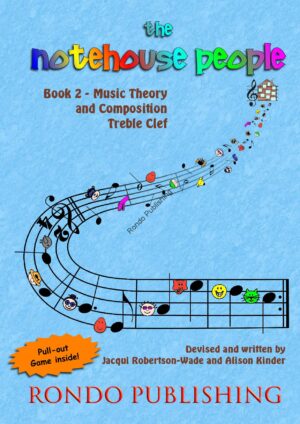Music Theory The Notehouse People
The Notehouse People was written by someone who really understands how hard it can be for children to grasp note reading as she was diagnosed as being mildly dyslexic as an adult. Jacqui Robertson-Wade writes: ‘Over the years I have come up with strategies to overcome my own difficulties and from years of teaching I could see what children needed to help them differentiate between symbols that essentially can all look the same. By using a child’s natural resource, imagination, another world can open up and difficulties can be overcome.’
There are many music theory methods available, but The Notehouse People is different as it works on recognition through imagination. Each note on the stave is a character, with a memorable sentence to accompany it. Along with the ‘place where it lives on the stave’ each character can be memorised easily. Piano teachers have found this method particularly useful.
Dorothy Cyster, piano teacher in Perth, Scotland, writes: “The pupils seem to identify with the character which they can remember easily, and become their little friends. Eight year old Georgina now enjoys doing her music theory and drawing in each character. She says ‘It’s fun!’ The Notehouse People makes note learning much more fun and less of a chore for both teacher and pupil. I have found that note rhythms and other theory books take time to work with most beginners.”
Another of Dorothy Cyster’s pupils, whose note reading skills have been very slow due to dyslexia, also tried The Notehouse People. She comments: “He is beginning to connect the theory with practice and has quickly learned the characters names. He says they are ‘cool’ and particularly likes the eggheads! The colour coding is especially helpful in identifying notes at different octaves.”
Music Teacher magazine reviewed The Notehouse People in April 2008 and Frances Taylor wrote: “The Notehouse People is an excellent starting point for note reading and an innovative and fun way of learning to read music. Altogether it is an imaginative and most useful resource.”
Showing all 3 results
- Select options This product has multiple variants. The options may be chosen on the product page
- Select options This product has multiple variants. The options may be chosen on the product page
- Select options This product has multiple variants. The options may be chosen on the product page



